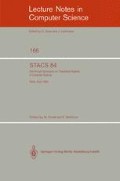Abstract
Computational geometry, considered a subfield of computer science, is concerned with the computational aspects of geometric problems. The increasing activity in this rather young field made it split into several reasonably independent subareas. This paper presents several key-problems of the classical part of computational geometry which exhibit strong interrelations. A unified view of the problems is stressed, and the general ideas behind the methods that solve them are worked out.
Preview
Unable to display preview. Download preview PDF.
References
Aho, A.V., Hopcroft, J.E., and Ullman, J.D. The design and analysis of computer algorithms. Addison-Wesley, Reading, Mass., 1974.
Brown, K.Q. Geometric transforms for fast geometric algorithms. Ph.D.Thesis, Rep. CMU-CS-80-101, Dep.Comp.Sci., Carnegie-Mellon Univ., Pittsburgh, Penn., 1980.
Cole,R., Sharir,M., and Yap,C.K. Convex k-hulls and related problems. Manuscript.
Edelsbrunner, H. Intersection problems in computational geometry. Ph.D.Thesis, Rep.F93, Inst.Inf.Proc., Tu Graz, Austria, 1982.
Edelsbrunner,H., Guibas,L.J., and Stolfi,J. Optimal point location in a monotone subdivision. Manuscript.
Edelsbrunner,H., O'Rourke,J., and Seidel,R. Constructing arrangements of lines and hyperplanes with applications. Proc. 24th Ann. Symp. Found. Comp. Sci. (1983), 83–91.
Edelsbrunner, H. and Welzl, E. Halfplanar range search in linear space and O(n0.695) query time. Rep.Flll, Inst.Inf.Proc., Tu Graz, Austria, 1983.
Graham,R.L. An efficient algorithm for determining the convex hull of a finite planar set. Inf. Proc. Lett. (1972), 132–133.
Gruenbaum, B. Convex polytopes. Pure and applied math. XVI, Interscience, London, 1967.
Kirkpatrick, D.G. Optimal search in planar subdivisions. SIAM J. Comp. 12 (1983), 28–35.
Kirkpatrick,D.G. and Seidel,R. The ultimate planar convex hull algorithm? Proc. 20th Ann.Allerton Conf. Comm., Contr., Comp. (1982), 35–42.
Knuth, D.E. Retrieval on secondary keys. Chapter 6.5 in Knuth, D.E.: Sorting and searching — the art of computer programming III. Addison-Wesley, Reading, Mass., 1973.
Lee, D.T. On k-nearest neighbor Voronoi diagrams in the plane. IEEE Trans. Comp. C-31 (1982), 478–487.
Lipton,R.J. and Tarjan,R.E. Application of a planar separator theorem. Proc. 18th Ann. Symp. Found. Comp. Sci. (1977), 162–170.
Lozano-Perez, T. Spatial planning: a configuration space approach. IEEE Trans. Comp. C-32 (1983), 108–120.
Megiddo,N. Linear-time algorithms for linear programming in R3 and related problems. Proc. 23rd Ann. Symp. Found. Comp. Sci. (1982), 329–338.
Nievergelt, J. and Preparata, F.P. Plane-sweep algorithms for intersecting geometric figures. Comm. ACM 25 (1982), 739–747.
Overmars,M.H. The design of dynamic data structures. Lect. Notes Comp. Sci. 156, Springer, 1983.
Overmars, M.H. The locus approach. Rep. RUU-CS-83-12, Dep.Comp.Sci., Univ. Utrecht, the Netherlands, 1983.
Preparata, F.P. and Hong, S.J. Convex hulls of finite sets of points in two and three dimensions. Comm. ACM 20 (1977), 87–93.
Schmitt, A. On the time and space complexity of certain exact hidden line algorithms. Rep. 24/81, Fak.Inf., Univ. Karlsruhe, Germany, 1981.
Seidel, R. A convex hull algorithm optimal for point sets in even dimensions. Rep. 81-14, Dep.Comp.Sci., Univ. British Columbia, Vancouver, 1981.
Shamos, M.I. Computational geometry. Ph.D.Thesis, Dep.Comp.Sci., Yale Univ., New Haven, Conn., 1978.
Shamos,M.I. and Hoey,D. Closest-point problems. Proc. 16th Ann. Symp. Found. Comp. Sci. (1975), 151–162.
Voronoi, G. Sur quelques proprietes des formes quadratiques positives parfaites. J. reine angew. Math. 133 (1907), 97–178.
Author information
Authors and Affiliations
Editor information
Rights and permissions
Copyright information
© 1984 Springer-Verlag Berlin Heidelberg
About this paper
Cite this paper
Edelsbrunner, H. (1984). Key-problems and key-methods in computational geometry. In: Fontet, M., Mehlhorn, K. (eds) STACS 84. STACS 1984. Lecture Notes in Computer Science, vol 166. Springer, Berlin, Heidelberg. https://doi.org/10.1007/3-540-12920-0_1
Download citation
DOI: https://doi.org/10.1007/3-540-12920-0_1
Published:
Publisher Name: Springer, Berlin, Heidelberg
Print ISBN: 978-3-540-12920-2
Online ISBN: 978-3-540-38805-0
eBook Packages: Springer Book Archive

